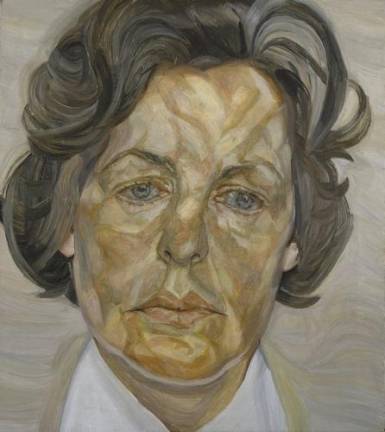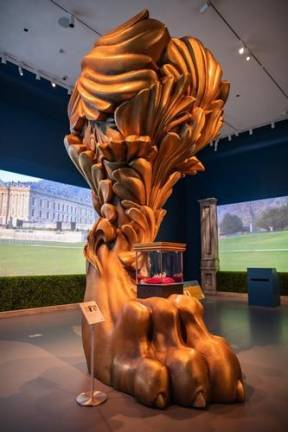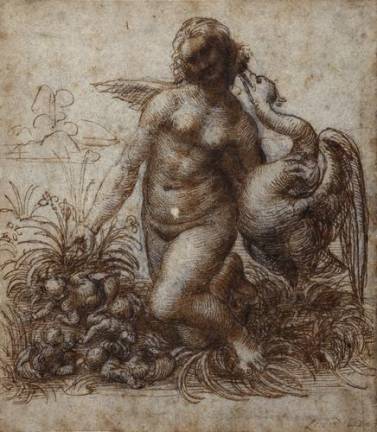A collector’s paradise
Sotheby’s hosts art treasures from England’s Chatsworth House in its newly expanded galleries on York Ave



Who can forget Keira Knightley, as Elizabeth Bennet, roaming the sculpture gallery at Pemberley, Mr. Darcy’s manse, in the 2005 film adaptation of “Pride and Prejudice”? It turns out the scene was shot at Chatsworth House in Derbyshire, in a room filled with sculptures acquired over centuries by the Cavendish family, aristocrats who were mad about collecting fine art, furniture, ceramics, silver, jewels, books and textiles — treasures galore.
Chatsworth’s current proprietor, the 12th Duke of Devonshire, goes by the nickname “Stoker.” He and his wife Amanda, the Duchess of Devonshire, are guardians of this historic cache, one of the finest private collections of art and objects in Europe, acquired over 500 years by 16 generations of Cavendishes.
Some 45 choice specimens from the Devonshire Collection were selected to travel to New York this summer for a presentation at Sotheby’s, nicely coinciding with the auction house’s 275th anniversary celebration in 2019. (None of the items are for sale; see the adjacent Chatsworth-themed exhibit if you are in the mood to buy.)
A Passion for the “New”
The pieces reflect the tastes of the owners. The 2nd Duke was fond of Old Master drawings, the 6th Duke of sculpture, especially works by Antonio Canova and Raffaelle Monti. Note the latter’s “Veiled Vestal Virgin” (c. 1846-47), with its extraordinary marble veil — especially if you missed its star-turn opposite Keira Knightley in “Pride.”
Thomas Lawrence’s portrait of the 6th Duke, William Spencer Cavendish, dated 1811, hangs in the same room, along with a trio of 17th century paintings that includes Rembrandt’s “Portrait of an Old Man” (1651), rarely seen at Chatsworth, which is open to the public. Oddly enough, what unites the collection, which spans the 16th to 21st centuries, is its contemporaneousness. The fine art and the decorative art, the furniture and the costumes, are largely a reflection of successive occupants’ fancy for the latest styles and fashions — a passion for the “new.”
These collectors were rooted in their times, and they were not afraid to break with tradition and go with their gut if it felt right. The current Duke and Duchess’ approach can be summed up as: “If you like something enough you should collect it if you can, and disregard other people’s opinions.”
Hence the display in the second gallery, a showcase for cutting-edge 21st century sculpture and furniture mixed in with paintings and drawings from the 20th century by the likes of Picasso and Lucian Freud. All the works were commissioned, except for Picasso’s early “Self-Portrait in Front of the Moulin Rouge, Paris” (1901).
Extravagant Items in Extravagant Settings
The 11th Duke and Duchess, parents of Stoker, took a special interest in acquiring contemporary art and befriended Freud, grandson of Sigmund Freud. Lucian was commissioned to paint likenesses of both the Duke and Duchess. The expressive, world-weary “Woman in a White Shirt” (1958-60) was well received by the Duchess (“Debo,” the former Deborah Mitford). But alas, as Stoker recalls, his parents’ friends “so disliked it that some of them refused to be in the sitting room with it unless it was completely covered.”
Those oddly configured chairs and love seat in the gallery, the “Enignum” pieces (2010, 2016), are the handiwork of Irish furniture maker Joseph Walsh, whose designs the present Duke discovered by chance in a shop window on Bleecker Street. A relationship ensued, and the Duke now proclaims: “Apart from some of our contemporary ceramics, Joseph Walsh’s furniture gives us more pleasure than anything we have collected.”
Part of the fun here is seeing extravagant items, like the Devonshire diamond tiara, in extravagant settings, created by Broadway’s David Korins, the scenic designer of “Hamilton.” He’s isolated interesting architectural details from Chatsworth House, such as the claw foot of a table, and created large-scale, sculptural equivalents to frame or complement the treasures.
No surprise, the historic part of the collection holds its own in this arena. The sight of Thomas Gainsborough’s portrait of society hostess Georgiana Cavendish (c. 1776) — a Spencer, wife of the 5th Duke of Devonshire and a gambling addict — sparks another eureka moment: she’s the figure portrayed in that other period film starring Keira Knightley, “The Duchess,” based on Amanda Foreman’s biography.
A Digital Portrait and a Da Vinci
At Sotheby’s, Georgiana faces off in the family-portrait space with John Singer Sargent’s classic oil painting, “Evelyn, Duchess of Devonshire” (1902), and a real curveball, Michael Craig-Martin’s kaleidoscopic “Digital Portrait of Laura, Lady Burlington” (2010), a “live” computer image of the daughter-in-law of the present Duke and Duchess. And, no, your eyes are not fooling you: Laura’s features and clothing are changing color. She never looks the same.
Something old, something new may best describe the curatorial MO here. The Old Master drawings, one of the collection’s big draws, speak volumes about connoisseurship. Leonardo da Vinci’s “Leda and the Swan” (c. 1506), acquired by either the 2nd or 3rd Duke in the 18th century, is on view, the first time the mythological drawing has traveled to New York since 2003. It was loaned out to a Leonardo exhibit in Milan in 1939 and survived the Second World War with minimal damage — just a white mark in the middle of Leda’s abdomen.
Call it a win for the Devonshire Collection and art lovers who visit Sotheby’s this summer.